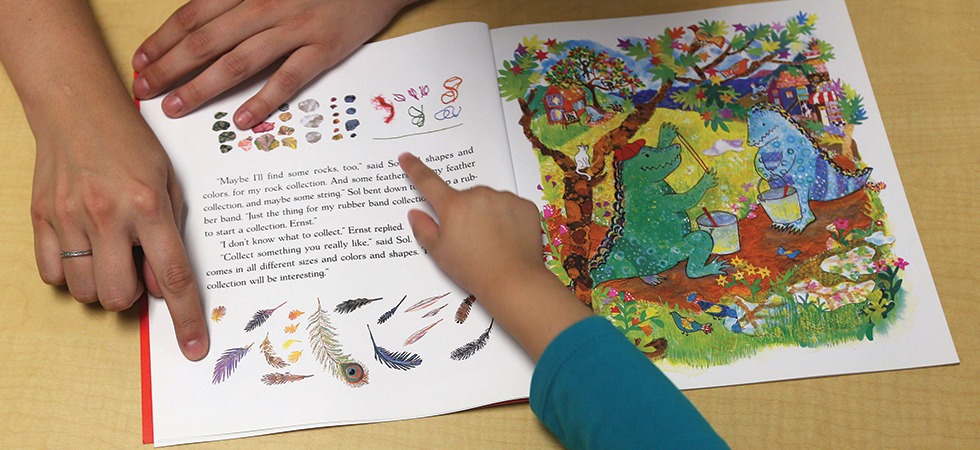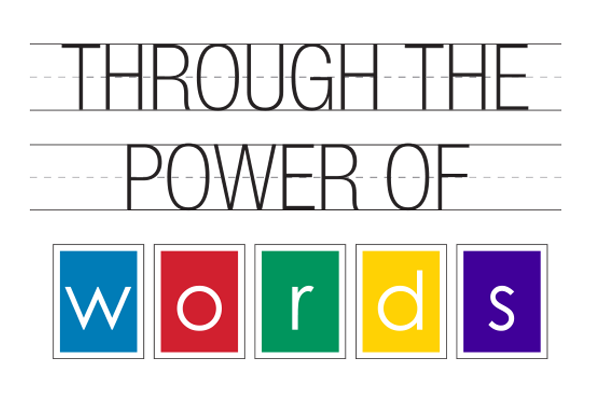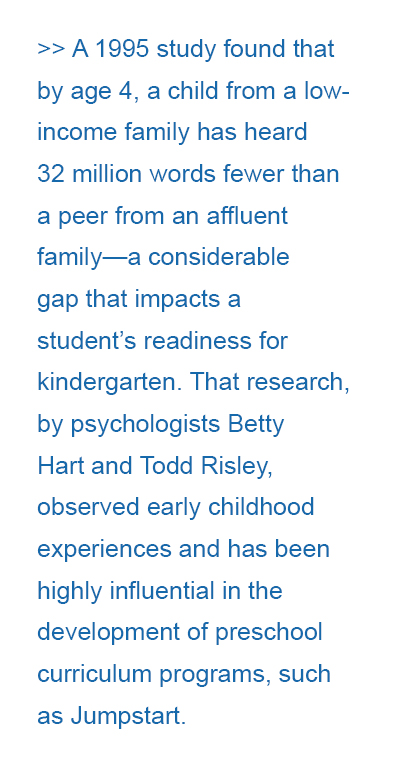SPRING 2015 / JUMPSTART
East Los Angeles children prepare for kindergarten
with help from Cal State L.A.’s students.
BY KATE KEALEY
Nancy Duran’s class looks like any other preschool class. Four-year-olds jockey for the attention of teachers, squirm across the rug during group time and practice their manners while requesting toys out of reach.
The difference between this class in East Los Angeles and others in more affluent areas rests in the unseen.
“Most of the families live in apartments,” says Duran, lead teacher at the Mexican American Opportunity Foundation’s (MAOF) Telegraph Child Care Center preschool. “Some have six children and they don’t have a space to play. Sometimes even paying for food can be hard.” The challenges faced by families in low-income areas can have an adverse effect on a child’s ability to learn, says Duran. With only three teachers in a classroom of up to 21 wriggling tykes, it’s tough to keep everyone on task and give each student one-on-one time.
Since November, Duran has had help from Cal State L.A. students several times a week through Jumpstart.
Jumpstart is a supplemental program that trains volunteers to help preschool-aged children in low-income neighborhoods develop the language and cognitive skills needed to be successful in school. The nonprofit has trained 36,000 college students and volunteers since its founding in 1993. Jumpstart is unrelated to Head Start, the federal program that helps fund and oversee early education programs.
This is the first year that Cal State L.A. has participated in Jumpstart. Student teachers are managed by the Center for Engagement, Service, and the Public Good, the campus office responsible for implementing President William A. Covino’s mission of community engagement. Jumpstart is a program of the center’s GO East LA initiative, which seeks to improve academic outcomes for East L.A. students. This cradle-to-career initiative recognizes that success in higher education begins in early childhood. GO East LA is operated in collaboration with the Los Angeles Unified School District and East Los Angeles College.
Cal State L.A. has partnered with MAOF to place 23 university students in three of the foundation’s child care sites in East L.A. Cal State L.A. students commit 300 hours to the program and receive a financial award from AmeriCorps, the corporation for national and community service.
The program works by lowering the teacher-to-student ratio, which allows for preschoolers to receive more personal attention.
“Studies [such as Hart and Risley] show that young children in low-income areas hear fewer words than children from more affluent areas,” says Kortney Hernandez, Jumpstart coordinator at Cal State L.A.
Equipped with lesson plans, books and activities, Cal State L.A. students can help introduce new words.
One cold, gray morning in January, the topic turns to pizza as seven Cal State L.A. students lead groups of two or three preschoolers in a reading of Little Red Hen Makes a Pizza by Philomen Sturges. As sociology major Stephanie Rojas flips the pages, small flourescent green Post-Its remind her to emphasize new words in the text.
“Do any of you know what an anchovy is?” she asks the children. One boy said he knew it was food. Later, lessons and words from the book are slyly re-emphasized multiple times during activity and group time. When the children are invited to paint a pizza, the Cal State L.A. students ask them about their favorite toppings. None of them admitted to liking anchovies.
After a couple of weeks, the conversations go beyond favorite pizza toppings as the Cal State L.A. students learn more about the children and watch them grow confident with each new skill. Relationship-building is a key component of the program, says Hernandez. The Jumpstart student teachers are trained to seek to develop authentic relationships.
“The volunteers can tell they are building true relationships when the children are responsive to their interactions,” says Hernandez. “Children are going to test them, but when they are firm but patient, true and genuine relationships develop.”
Six months in, the Cal State L.A. students have made a big impression on the children, says Duran.
"The children run toward them and they hug them,” she says. “They’re always asking if the Jumpstart teachers are coming today.”
For Cal State L.A. students, this is a prime opportunity to learn about the challenges facing the community and to be a part of creating change, says Hernandez.
Many of the university students are attracted to the program because they had similar experiences growing up.
Indeed, Rojas says she remembers what it felt like to be withdrawn at school. Early in her childhood, her father left home frequently in search of work until one day he never came back. She was raised by a single mother who only spoke Spanish and found work wherever she could. “When I was in preschool and people asked me about my dad … that killed me,” she recalls. “I wanted to keep to myself.”
Preschoolers haven’t developed the cognitive skills to understand or talk about complex life situations. When problems arise at home, they deal with it in other ways. They act out or become withdrawn like Rojas once was.
“That affected me a lot, because when I was keeping to myself I could have been learning,” says Rojas. “Sometimes when I see kids sitting alone I try to get them to engage and open up. At first, they are like ‘no,’ but maybe in a few weeks they will see me and remember that I paid attention to them and want me to read to them. I wish I had that when I was younger.”


